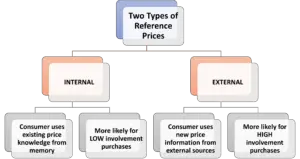What is the Difference between Internal and External Reference Prices?
The word “reference” means that a consumer is referring to knowledge or information in order to assess the acceptable price range for a specific product and/or brand.
There are two possibilities for the consumer to gain this price information. These are:
- Internally
- Externally
Internal Reference Prices
An internal reference price range is one that is internal an individual to the consumer. That means that the information is coming from the consumer’s accumulated knowledge and memory of prices.
The consumer through their ongoing purchase actions – that is, regularly buying products over time – will accumulate knowledge of acceptable price ranges for many products and brands. This is stored in their memory and can be accessed as required to assist with their purchase decisions.
Obviously, most consumers will not recall the precise price of all products, but they will have a good understanding of what they would expect to pay for different product categories, particularly for those products that they purchase on a regular basis.
Many low involvement purchase products, such as everyday food and groceries, would fall into this category. For these types of products, the consumer would have an upper and lower limit of acceptable price points.
Therefore, when the consumer goes shopping to buy a can of soup for example, they would have a good understanding and expectation of the approximate price of a can of soup. They will not purchase products that are priced well above or well below their reference price range.
External Reference Prices
For products that consumers do not purchase regularly they will not have the same level of pricing knowledge. Likewise with high involvement purchases, which are very important to the consumer, they will seek to clarify the expected and acceptable price range of the product.
In these cases, the consumer will refer to external price information and not rely upon their internal memory.
External price information is typically gained by the consumer through:
- the actions of shopping around between stores,
- observing prices and signage,
- reviewing advertising,
- undertaking internet research, and
- even asking family and friends.
Why Consumers Will Use Internal Reference Prices?
Internal reference prices are a handy heuristics tool for consumers to allow them to make fast decisions, such as when going to the supermarket. They can quickly assess whether the product offers value by comparing it to their mental memory of price ranges.
Why Consumers Will Use External Reference Prices?
External reference prices are more important in high involvement purchases where the consumer is committed to making the “right purchase decision” and choosing the most suitable and best value product.
Because the purchase decision is more important, the consumer will actively seek out external information, rather than relying upon any internal/memory information, to make a more informed choice. This should lead to reduced post purchase dissatisfaction.
Related Articles

